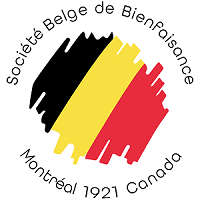Origins and creation
The Belgian Benevolent Society was born in 1921 in the minds of a number of people who were aware of the difficulties that Belgian immigrants could encounter upon their arrival in Canada.In the aftermath of the First World War, immigrants, regardless of nationality, could not count on a social safety net comparable to the one that exists today.
Frequently, the individual in need had to turn to volunteer organizations for help.Although the annual contingent of immigrants of Belgian origin was not very large, many of them approached the consulate of their country of origin hoping that it would have the necessary resources to support compatriots in need.Therefore, it is logical that it was around the Belgian consul in Montreal that a number of Belgians expressed the intention to regroup in order to create the Belgian Benevolent Society.
The founders' letters patent dated June 24, 1921
- J.Mr. Corneille Van Rickstal, Consul of Belgium in Montreal;
- Gustave Francq, printer;
- H. Joseph Chaballe, Chancellor of the Belgian Consulate;
- Léon Van Aken and Alfred Ducastel, commercial agents;
- François Baudelet, employee of the Canadian Pacific;
- Emery De Boeck, merchant;
- Herman de Burlet, charterer;
- Pierre Demangeleer, Jesuit Father at St. Mary's College;
- Has. François Fyen, Director of École Polytechnique de Montréal;
- J.F.L. Henry Laureys, Director of the École des Hautes Études Commerciales;
- Albert Gheysen, civil engineer.
The Society was under the honorary presidency of the Minister of Foreign Affairs of Belgium and the Consul General of Belgium in Ottawa. The first Board of Directors was composed of Mr. Alfred Du Castel, President; Léon Van Aken, secretary; J.J. Goulet, Assistant Secretary; H.J. Chaballe, treasurer.
Early years
Unfortunately, it is impossible to trace the Company's activity during this initial period, as no documents or archives have been preserved.Only a few bits of information have reached us.Thus, it appears that as early as 1922 the Society was experiencing difficulty in satisfying the large number of requests from unemployed persons.
Between June and December 1922, expenses amounted to $523.53 while cash was only $49.86!
The Council immediately reacted to this situation by adopting measures to increase resources.A charity ball was organized at the Ritz-Carlton in Montreal as well as a public collection (an initiative that extended the Belgian Tag Day during the war).The ball became an annual activity that became part of the calendar of socialites of the Belgian community.We would have liked to know how the Society responded during the Great Depression. The absence of documents forces us to remain silent and to refer to the end of this period.
Belgium-Canada Association
In 1936, at the instigation of Louis Empain, the Belgium-Canada Association decided to deploy its activities in Montreal.Although its primary ambition was oriented towards the economic sector, this association soon brought together under its wing the Belgian Benevolent Society.It counted on the financial support of its promoter to find a second wind.
The transfer took place and from 1937, the activities of the SBB were carried out by the Benevolent Circle of the Belgium-Canada Association.This change was only a change of label since it was the members of the Board of Directors of the SBB who led this Circle.
On the eve of the Second World War, the Circle set up a Ladies' Committee.The future demonstrated the relevance of this decision.
A cloakroom responsible for distributing clothes to the needy was added to the financial relief.Thousands of pieces of clothing were sorted, packed and distributed by volunteers, including the dedication of Kittel, Fyen and Lecart.
It seems that this action was combined with that of the Red Cross.
The end of the Circle and renewal
At the beginning of 1948, the Circle was dissolved.On 20 October of the same year, the charter of the Belgian Benevolent Society was reinstated.The years up to 1970 appear to be a period of stagnation.
Fortunately, this situation was rectified thanks to the initiative of the Belgian Consulate in Montreal and the activity of three presidents: Hubert Van Gijseghem, Pierre Bataille and André Vermeirre.The role of successive councils and active members should be emphasized here.
This new impetus gave rise to activities adapted to the transformation of the socio-economic context at the end of the century.New attention was paid to the elderly and students.
For example, the fiscal year 1991-1992
That year the Society distributed about $16,000, broken down as follows.
- Five thousand dollars to individual help.
- Five thousand-dollar university scholarships.
- Two hundred people over the age of 65 attended a free Christmas dinner.
- Eighty Belgians over the age of 80 received a home visit and a gift on the occasion of Christmas.
In terms of resources, the Corporation's finances were fuelled by interest on its capital and the annual charity dinner at the Mount Stephen Club.We could also rely on the interests of the Biermans Fund. At the time of his death, this philanthropist, well known to the Belgians, had donated $25,000 administered by a trust.
In 1996, Pierre Renaut became president and was succeeded by Marc Baje.Three years later, it was Nicole Conrath's turn to head the Belgian Benevolent Society together with her husband, the faithful secretary. On March 25, 2010, Dr. Roger Ghys succeeded Nicole Arnould-Conrath.In March 2012, it was the turn of Mr. Louis Daubois to assume the presidency. In March 2015, Dr. Roger Ghys returned to the presidency of the SBB.
Spring: André Vermeirre (November 2011)
Born in Belgium, Mr. Vermeirre has taught history at CEGEP and Université de Montréal.He holds a master's degree in history and a Ph.D. in medieval sciences.Mr. Vermeirre has written several books including: Hubert Biermans and L'immigration des belges au Québec published by Les éditions du Septentrion.
